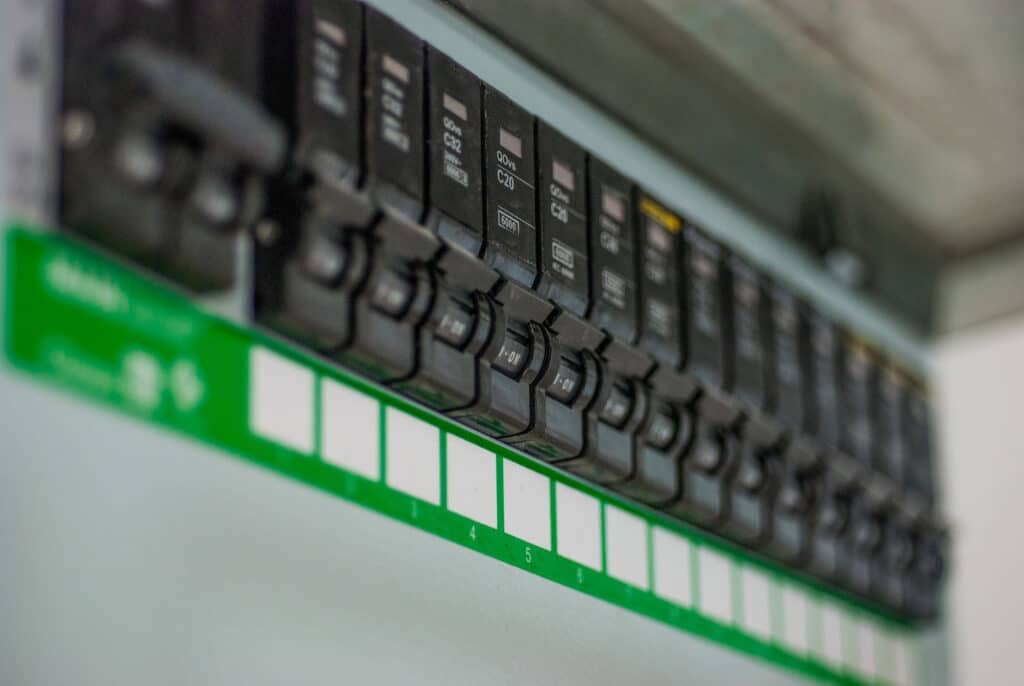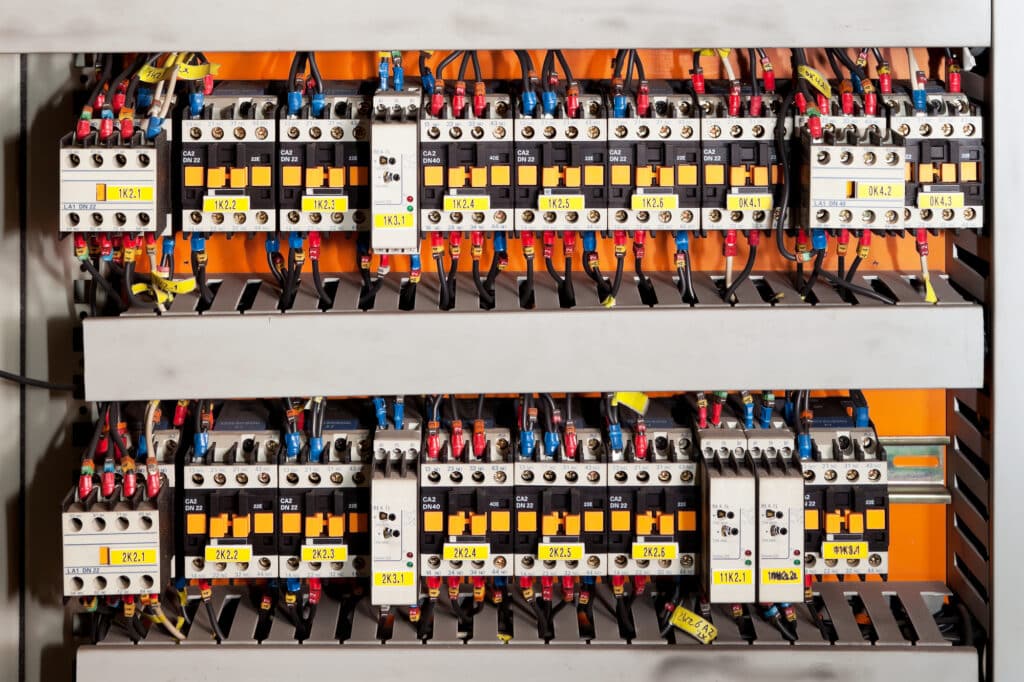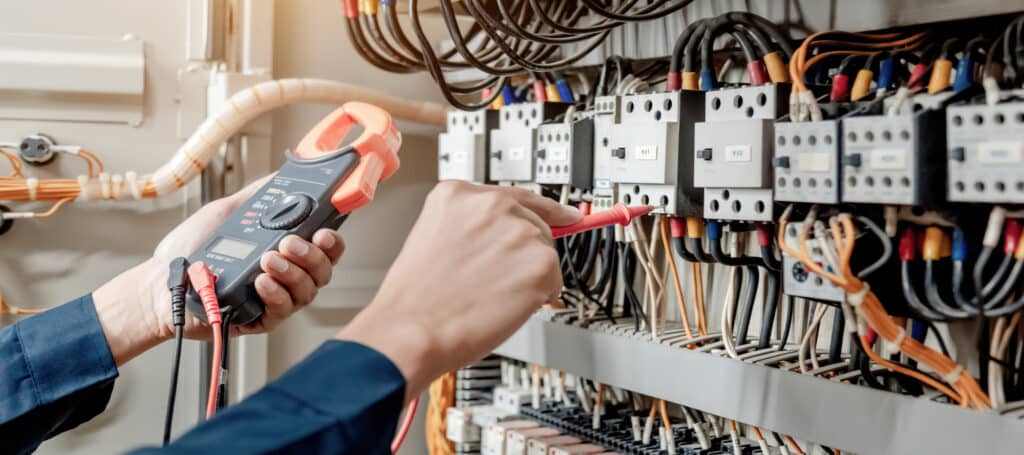Electrical Panel Upgrades and Installation
If your breaker box in San Francisco is outdated, consider an electrical panel upgrade. This can help meet the power demands of today’s world. Don’t let a lack of adequate electrical power slow you down: get in touch with a qualified San Francisco electrician now!
The breaker box installed when your home was built was likely enough to power a few lights, electrical outlets, and basic appliances. However, it may not have the capacity to keep up with today’s technology and your energy needs. The great news is that professional electricians in San Francisco can assist you and your home with an electrical service installation or upgrade. This will boost your building’s electrical capacity to meet today’s demands.
From the very beginning, Andrade Link Electric has strived to offer unparalleled panel upgrade services and installation services in San Francisco. Our electricians, who specialize in panel upgrades and installation, will treat you and your home with utmost respect throughout the project. They will keep homeowners informed at every stage of the process, ensuring their complete satisfaction with the final result.
Our contractors pay extra attention to details, ensuring that each project is completed with exceptional quality. With years of experience in the field of panel upgrades, our professionals can complete projects on time with superior quality. Regardless of what your panel upgrade or electrical needs are, our San Francisco electricians have the expertise and knowledge to provide top-notch service.

When Should You Repair or Replace Your Electrical Panel?
Your electrical panel is a crucial part of your home. It’s like the heart of your electrical system, pumping electricity to every corner of your house. But just like any other part of your home, it can wear out over time. So, how do you know when it’s time to repair or replace your electrical panel? Here are some signs to look out for:
1. Frequent Circuit Breaker Trips
If your circuit breakers are tripping frequently, it could be a sign that your electrical panel needs attention. This usually happens when the panel can’t handle the amount of electricity flowing through it.
2. Flickering Lights
When lights flicker or dim, it might mean that your electrical panel is struggling to distribute power evenly. This could be due to an overloaded circuit or a faulty panel.
3. Old Age
Electrical panels typically last between 25 and 40 years. If yours is older than this, it might be time to consider a replacement.
4. Burnt or Discolored Breakers
If you notice any burnt or discolored breakers, it’s a clear sign that something is wrong. This usually indicates a dangerous situation that requires immediate attention.
5. Use of Fuses Instead of Circuit Breakers
Older homes often have fuse boxes instead of modern circuit breakers. Fuses are not as safe as circuit breakers, so if your home still uses them, it’s probably time for an upgrade.
Types of Electrical Panels for Homes
Main Breaker Panel
The main breaker panel is the most common type of electrical panel found in homes. It has a large circuit breaker that can shut off all power to the house. This panel is usually located near where the electricity enters the home.
Main Lug Panels
Main lug panels are similar to main breaker panels, but they don’t have a main circuit breaker. Instead, the lugs in the panel are connected directly to the service lines. These panels are often used as distribution panels downstream from the main circuit breaker box or panel.
Subpanels
Subpanels are smaller panels that distribute electricity to a specific area of the home, like outdoor electrical panels in a garage or workshop. They are connected to the main panel and can be shut off independently.
Transfer Switches
Transfer switches are not exactly panels, but they are related. They are used with generators and allow you to switch between utility power and generator power during a power outage.
Fuse Boxes
Fuse boxes are an older type of electrical panel. Instead of using circuit breakers, they use fuses. When a circuit is overloaded, the fuse will blow and need to be replaced. While these are less common today, some older homes still have them.
The Electrical Panel Installation Process

Mounting a circuit breaker panel is a task that requires careful attention and expertise. Here’s a simplified step-by-step guide on how we do it:
Choose the Location: The first step is to decide where the panel will be installed. It should be easily accessible, but also out of the way of daily activities.
Mount the Panel: Once the location is decided, they use a level to ensure the panel will be straight. They mark the wall where the screws will go, then drill holes and secure the panel with screws.
Install the Breakers: Next, they install the circuit breakers into the panel. Each breaker is designed to protect a specific circuit from overload.
Connect the Wires: After the breakers are in place, they connect the wires. Each wire is connected to its corresponding breaker.
Test the System: Finally, they test the system to make sure everything is working properly. This involves turning on the power and checking each circuit.
An electrical circuit breaker panel, also known as a distribution board, is a crucial part of any home’s electrical system. It’s the place where all the wires from different parts of your house come together. Here’s a simple guide on how it’s wired.
Step 1: Main Power Cable Connection
The main power cable comes into the panel with three wires: two hot wires and one neutral wire. These wires connect to the main breaker, which controls the power supply for household electrical systems throughout the entire house. The hot wires attach to the main breaker, while the neutral wire connects to the neutral bus bar.
Step 2: Circuit Breaker Installation
Next, individual circuit breakers are installed in the panel. Each breaker controls a specific area or appliance in your house. The hot wire from each circuit connects indoor panel to its respective breaker.
Step 3: Neutral and Ground Wires
The neutral and ground wires from each circuit are connected to their respective bus bars in the panel. The neutral wires go to the neutral bus bar, and the ground wires connect to the ground bus bar.
Step 4: Labeling
Finally, it’s important to label each circuit breaker. This makes it easy to identify which circuit breaker switch controls which part of the house if you need to turn off the power for any reason.
An “Open Knockout” in an electrical panel box is a term used to describe a hole that has been punched out or removed but is not currently being used. These holes, or knockouts, are designed to allow wires and cables to pass through the current electrical panel box.
When a knockout is open, it means there’s no cable or conduit running through it. This can be a safety concern because it leaves an opening where dust, debris, or even small animals could enter the panel box. It also exposes the inside of the panel box, which contains live electrical components, to potential damage.
To fix an open knockout, one should use a knockout seal or plug. This is a small piece of metal or plastic that fits into the hole and securely closes it off. By doing this, they can ensure the panel box remains safe and protected from any external elements.
Open knockouts in an electrical box can be a problem for several reasons.
1. Safety Hazard:
Open knockouts can expose live wires, creating a risk of electric shock. This is especially dangerous if someone accidentally touches the exposed wires.
2. Fire Risk:
If flammable material comes into contact with the exposed wires, it could ignite and cause a fire. This is a serious concern in areas where there are flammable materials nearby.
3. Damage to Electrical System:
Dust, dirt, and other debris can enter the electrical box through the open knockout. Over time, this can damage the electrical system and lead to malfunctions.
4. Violation of Building Codes:
Most building codes require all knockouts to be closed. Leaving them open could result in fines or other penalties.
5. Pest Entry Point:
Open knockouts can also provide an entry point for pests. Small insects and rodents can squeeze through these openings and cause damage to the wiring inside.
Cost To Replace vs. Upgrade an Electrical Panel
When it comes to dealing with an electrical panel, there are two main options: replacing or upgrading.
Cost of Replacing an Electrical Panel
Replacing an electrical panel involves removing the old one and installing a new one. The cost can vary widely depending on several factors. These include the type of new panel used, labor rates in your area, and whether any additional work is needed, such as rewiring. On average, you might expect to pay between $1,000 and $2,500 for this job.
Benefits of Replacing an Electrical Panel
The main benefit of replacing an electrical panel is that it can solve problems with outdated or faulty equipment. If your current panel is causing issues like frequent power outages or circuit breaker trips, a replacement could be the best solution.
Cost of Upgrading an Electrical Panel
Upgrading an electrical panel usually means increasing its capacity. This is often necessary if you’re adding new appliances or electronics that demand more power than your current system can handle. The cost of an electrical service upgrade can range from $1,300 to $3,000, depending on the size of the upgrade and other factors.
Benefits of Upgrading an Electrical Panel
The primary advantage of upgrading an electrical panel is that it allows for future expansion. If you plan to add more devices or appliances, or if you’re considering a home addition, an upgraded panel will be able to handle the increased load.


Remember, dealing with electricity is not a DIY job. Always hire a professional to ensure the work is done safely and correctly. By following these tips, you can find the best electrician in San Francisco to handle your electrical panel needs.
Finding the Best Electrician San Francisco
Trust Your Electrical Panel Upgrade to a Professional
When looking for an electrician in San Francisco, consider these factors:
Experience: An experienced electrician has likely dealt with a wide range of issues and can handle unexpected problems that may arise during a job.
Licenses and Certifications: Make sure the electrician is licensed and certified. This ensures they have undergone proper training and adhere to safety standards.
Reviews and Recommendations: Check out reviews online or ask friends and family for recommendations. This can give you a good idea of the quality of their work and customer service.
Pricing: Get quotes from multiple electricians to ensure you’re getting a fair price. Remember, the cheapest option isn’t always the best. Quality workmanship and safety should never be compromised.
Questions to Ask An Electric Company Before Hiring for Your Panel Upgrade
Does upgrading your electrical panel increase your home's value?
Yes, upgrading an electrical panel can increase a home’s value. This is because a modern, upgraded electrical panel can handle more electrical load than older panels. It means that the house can support more appliances and devices at once without tripping breakers or causing other electrical issues.
Potential buyers often see this as a major plus. They don’t have to worry about the cost and hassle of upgrading the panel themselves. Also, an upgraded electrical panel can make a home safer by reducing the risk of electrical fires. This safety factor can also add to the overall value of the home.
However, it’s important to note that while an upgraded electrical panel can increase a home’s value, it might not lead to a dollar-for-dollar increase in the selling price. The exact amount of value added will depend on various factors, including the real estate market in your area and the condition of the rest of the house.
How To Save on Electrical Panel Costs?
An electrical panel is a crucial part of any home. It’s where the electricity from the power company enters your house and gets distributed to all the different rooms and appliances. However, maintaining or replacing an electrical panel can be costly. Here are some tips to help you save money on electrical panel costs.
1. Regular Maintenance
Regular maintenance can prevent major problems that could lead to expensive repairs. This includes checking for loose connections, corrosion, or signs of overheating. If you’re not comfortable doing this yourself, consider hiring a professional electrician for a yearly check-up.
2. Energy Efficiency
Investing in energy-efficient appliances and light bulbs can reduce the load on your electrical panel, which can extend its lifespan. Also, remember to turn off lights and unplug devices when they’re not in use.
3. DIY Repairs
Some minor repairs can be done by yourself if you have basic knowledge about electrical systems. However, always prioritize safety and don’t attempt to fix anything if you’re unsure.
4. Shop Around
If you need to replace your electrical panel, get quotes from several electricians. Prices can vary significantly, so shopping around can help you find the best deal.
5. Plan Ahead
If you’re planning a major renovation or addition to your home, consider upgrading your electrical panel at the same time. This can be more cost-effective than doing it separately
Cost To Install a Main Breaker?
Installing a main breaker is an important task that ensures the safety of your electrical system. The cost to install a main breaker can vary greatly depending on several factors.
Factors Affecting the Cost
Type of Breaker: There are different types of breakers, and each comes with its own price tag. For instance, standard circuit breakers are generally less expensive than ground fault circuit interrupters (GFCIs) or arc-fault circuit interrupters (AFCIs).
Labor Costs: The cost of labor can also significantly affect the total cost. This depends on the electrician’s experience, location, and the complexity of the job.
Additional Materials: Sometimes, additional materials may be needed for the installation, such as new wiring or a new electrical panel. These will add to the overall cost.
Permits and Inspections: Depending on your local regulations, you might need to get a permit and have the work inspected, which will also add to the cost.
Estimated Costs
The average cost to install a circuit breaker, including labor, ranges from $150 to $200. However, if you need to replace or upgrade your entire electrical panel, the cost could go up to $1,000 to $2,500 or more.
Should I Upgrade My Home’s Electrical Panel?
Upgrading the electrical panel in your home can be a big decision. There are several factors to consider before making this choice.
Age of Your Home: If your home is over 20 years old, it might be time to upgrade the electrical panel. Older homes often have outdated panels that may not meet current safety standards.
Frequent Circuit Breaker Trips: If the circuit breakers in your home are frequently tripping, this could be a sign that your panel needs an upgrade. This usually means that the panel is overloaded and cannot handle the amount of electricity being used.
Renovations or New Appliances: If you’re planning on renovating your home or adding new appliances, you might need to upgrade your panel. New appliances often require more electricity, which your current panel might not be able to provide.
Flickering Lights: If the lights in your home flicker or dim when you use other appliances, this could indicate that your panel is struggling to distribute electricity properly.
Safety Concerns: Old or damaged panels can pose a safety risk. If you notice any signs of damage, such as rust or frayed wires, it’s important to get your panel checked out by a professional.
Do you provide services for both residential and commercial clients?
Yes, we provide services for both residential and commercial clients. Our team is equipped to handle projects of all sizes, from small home repairs to large-scale commercial renovations. We strive to deliver high-quality workmanship and customer service, regardless of the project’s scope.
What is the most expensive part of replacing an electrical panel?
The most expensive part of replacing an electrical panel is typically the labor cost. This includes the time it takes for a professional electrician to remove the old panel, install the new one, and ensure everything is working correctly. The cost can vary depending on the complexity of the job and the rates of the electrician.
However, the price of the new electrical panel itself can also be significant. Panels with more circuits or those that are designed for larger homes tend to be more expensive. Additionally, if your home requires any additional electrical work or upgrades to meet current safety standards, this could increase the overall cost as well.
